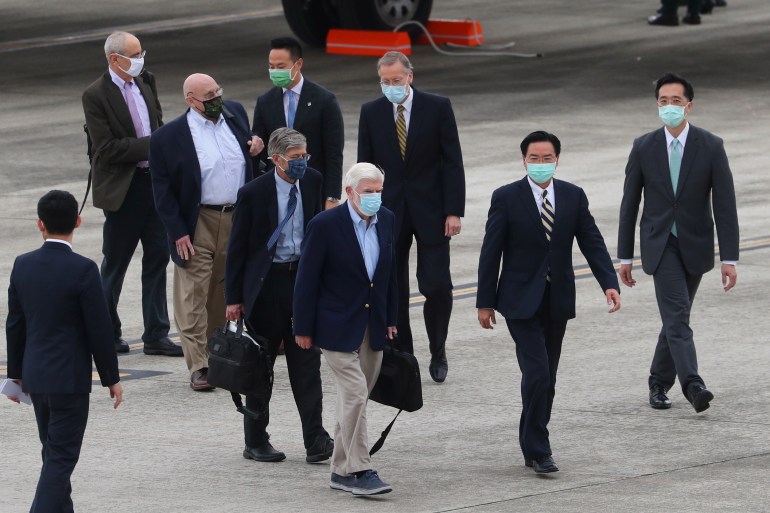Taipei, Taiwan – For the first time in more than half a century, the United States and Japan are expected this week to make a joint statement on the security of the Taiwan Strait following a meeting between US President Joe Biden and Japanese Prime Minister Yoshihide Suga.
While largely symbolic, the statement would be an indication of increasing concern about the security of the democratically-run island amid dire public warnings from senior US military officials about the threat of an invasion by Beijing, which claims the island as its own.
Admiral John Aquilino recently told a Senate Armed Services committee that taking Taiwan is a “number one” priority for China’s Communist Party, while US Asia Pacific commander Philip Davidson has said publicly that China could invade in the next six years.
Such fears may seem justified by the threatening tone of the Chinese state media and an escalating number of missions by PLA aircraft into Taiwan’s air defence identification zone (ADIZ).
But on the ground in Taiwan, people are neither running for one of the island’s 117,000 working bomb shelters nor enlisting en masse.
Having lived under the threat of Chinese military action for the past 70 years, the island’s 23 million people have come to understand what they consider the strange paradox of Taiwan’s existence: even as China’s military might grows, invasion does not necessarily come any closer.
Some experts believe much of the threat assessment by the US military may actually be more of a reflection of a shift in US perceptions about China amid the deteriorating relationship between the world’s two economic giants.
 Taiwan has been modernising its military, including developing new submarines and warships [Ritchie B Tongo/EPA]
Taiwan has been modernising its military, including developing new submarines and warships [Ritchie B Tongo/EPA]“This challenge is nothing new. Rather, it reflects an updated threat perception of the CCP and PLA in the context of US strategic competition with China.”
Bonnie Glaser, director of the China Power Project at the Center for Strategic and International Studies (CSIS), agrees.
The assessments, she says, are based not on intelligence but an analysis of the military balance between the US and China.
‘More difficult than D-Day’
China has stepped up its activities around Taiwan since Tsai Ing-wen was first elected president back in 2016.
While Tsai’s politics at home are viewed as largely maintaining the status quo in Taiwan’s complex relationship with China, abroad she is associated with a push for a unique Taiwanese identity that is separate from its historic ties to China.
Her politics and her administration’s close relationship with the US have angered Beijing, which claims Taiwan as its own despite having never ruled the island.
As part of Taiwan’s push for more political space, Tsai has sought to bolster Taiwan’s defences by raising the defence budget, reforming the reserves, improving its image from historical associations with the martial law era, and purchasing billions of dollars in arms from the US since taking office.
 President Tsai was first elected in 2016 and has faced an increasingly assertive China, which claims Taiwan as its own [File: Ritchie B Tongo/EPA]
President Tsai was first elected in 2016 and has faced an increasingly assertive China, which claims Taiwan as its own [File: Ritchie B Tongo/EPA]“The CCP has not given up on the use of force to invade Taiwan, and the Chinese military has continued to strengthen its combat readiness, and readiness to increase the CCP’s use of force,” the ministry said in a statement to Al Jazeera.
“There is always a risk of seizing Taiwan. Whether it is a sudden attack… or a full-scale invasion, it will seriously impact the country’s survival and development. Therefore, supporting the defense operations of various military building and preparation work is the core task of the national army.”
In late March, the Ministry of Defense said incursions into Taiwan’s ADIZ had become so frequent that it would no longer scramble to meet the aircraft each time and would instead track them with missiles. The Ministry said the decision was made on the assessment that the flights were consuming resources and increasing the risk of a miscalculation or accident.
And while some, particularly in the US, have begun to speculate that an amphibious invasion by the PLA is somewhere on the horizon, most experts take a more measured approach, stressing that an invasion of Taiwan carries significant risks for China.
First, its forces would have to cross the 180km (100-mile) Taiwan Strait with more than 100,000 soldiers and supplies, according to Michael Tsai, who served as Taiwan’s vice minister of defence and then minister of defence between 2004 and 2008.
En route, they would face aerial and naval bombardment and, if they managed to land, strong local resistance.
“If Taiwan was attacked by the PLA, more than two-thirds of young people would take affirmative action to resist Chinese action,” the former defence minister said. “Taiwan is a free and democratic country. We like to live in a peaceful coexistence with China but if we were attacked we have to react for some defences. Of course, will suffer a lot. Many young people will lose their life, but so will the PLA.”
 Taiwanese soldiers in action during the National Army Lunar New Year’s Military Exercise for Preparedness Enhancement inside a military base in Hsinchu in January [Ritchie B Tongo/EPA]
Taiwanese soldiers in action during the National Army Lunar New Year’s Military Exercise for Preparedness Enhancement inside a military base in Hsinchu in January [Ritchie B Tongo/EPA]For Taiwan expert and historian Bill Sharp, a former visiting scholar at National Taiwan University, such a manoeuvre would be “more difficult than a D-Day Landing” due to Taiwan’s geography, rough waters, and unreliable weather patterns. Its coastline also offers few suitable beaches, he said, for landing “armoured personnel carriers, tanks, artillery, or large numbers of invading troops.”
A missile attack, meanwhile, would lead to a far great of a loss of human life and destruction of infrastructure and would fuel opposition to any invading force.
“China would prefer to rule Taiwan as it physically is,” he said. “With their society violently attacked, Taiwanese will to fight will be piqued.”
Unknown ‘unknowns’
An invasion could also draw in Taiwan’s closest allies, such as the United States and Japan, posing too many unknowns for China’s leadership.
While the US is not guaranteed to come to the island’s defence, it has promised to help the island maintain “sufficient self-defence capabilities” as part of the 1979 Taiwan Relations Act.
CSIS’s Glaser says she does not believe China is yet ready to take such drastic action.
“Every Chinese leader has said reunification is inevitable,” she said. “Xi Jinping’s pronouncements on Taiwan aren’t very different from his predecessors,” she said, adding that China’s latest Five-Year-Plan called for the “peaceful development of Cross-Strait relations” with Taiwan.
Some experts believe much of the threat assessment by the US military may actually reflect a domestic shift within the US in perceptions of China. As China’s relationship with the US has soured, the threat perception of the PLA has also risen, said Project 2049’s Lee.
 Mechanics repair F-CK-1 Ching-kuo Indigenous Defence Fighters at an air force base in Tainan in January. The island has stopped scrambling for every Chinese incursion, instead tracking the aircraft with missiles [File: Ann Wang/Reuters]
Mechanics repair F-CK-1 Ching-kuo Indigenous Defence Fighters at an air force base in Tainan in January. The island has stopped scrambling for every Chinese incursion, instead tracking the aircraft with missiles [File: Ann Wang/Reuters]“The US knows that if China took the dominant position in the Asia-Pacific, it would have a detrimental effect against US national interests, so the US will try to defend the ‘first island chain’. Taiwan is in a strategic position as part of the first island chain. If Taiwan lost to China, it could become a PLA naval base that would threaten not only Japan but also US national security interests,” former defence minister Tsai said.
However, experts say Taiwan’s outlying islands could still be targeted.
“To seize Taiwan’s outer islands has always been on PLA’s practice agenda. If you take a look at geography, Taiwan’s outer islands are spread out, the ability to support one another is limited,” said James Huang, a retired Taiwanese lieutenant colonel turned military columnist.
China could easily blockade Taiwan’s port in Kaohsiung by taking its 240-hectare (593-acre) Pratas Island off the coast of Hong Kong or strengthen its position in the South China Sea by invading Taiping Island – also known as Ita Abu – in the Spratly Archipelago.
Huang said other relatively easy targets would include islands close to the Chinese coast including Liang Island and Gaodeng Island, which have few military personnel and are difficult to resupply by Taiwan’s main island.
Psychological warfare
Even if Taiwan may not face its doomsday scenario in the near future, it still faces a range of other challenges.
“Taiwan is no longer China’s main target, but the US is,” Huang said. “In terms of the biggest threat to Taiwan from China, it definitely is not the traditional military invasion.”
He believes Beijing’s focus is crippling Taiwan through economics and trade.
Faced with a weak economy and a strong neighbour next door, during non-COVID times, Taiwan faces a significant brain drain to China with hundreds of thousands opting for more competitive opportunities there.
“By increasing Taiwan’s economic dependence on China, it’s like the boiling frog syndrome, Taiwanese people will let their guard down,” he said.
As well as the regular airspace incursions, Taiwan has also been subject to psychological warfare from Chinese influence operations in the business and political world, and the continual push to squeeze Taiwan out of any international space, from the United Nations to the International Civil Aviation Organisation.
 Former US Senator Chris Dodd, former US Deputy Secretary of State Jim Steinberg and former US Deputy Secretary of State Richard Armitage walk with Taiwan Foreign Minister Joseph Wu and American Institute in Taiwan Director Brent Christensen as they arrive in Taipei on Wednesday [Central News Agency/Pool via Reuters]
Former US Senator Chris Dodd, former US Deputy Secretary of State Jim Steinberg and former US Deputy Secretary of State Richard Armitage walk with Taiwan Foreign Minister Joseph Wu and American Institute in Taiwan Director Brent Christensen as they arrive in Taipei on Wednesday [Central News Agency/Pool via Reuters]“To me and many strategists, we sense that China knows that taking actual military action would be the worst scenario for them as well,” he said. “Therefore, they are taking softer power action, including cyber warfare, psychological warfare, media warfare by penetrating Taiwan and getting disinformation into the newspaper to try to influence and mislead the population and also try to divide them.”
Glaser says rather than fixating on the potential for a Chinese invasion, the US would do better to support Taiwan against many of these other threats.
“The correct policy response by the US is not only to bolster military deterrence – we must make credible our ability to intervene and impose high costs on a PLA invading force – but we must also strengthen the US-Taiwan economic relationship, help Taiwan diversify its trade ties, and knit together a coalition of countries that will promote Taiwan’s participation in the international community and speak out in support of its democracy,” she said.
There are already signs that might be happening.
On Wednesday, as China conducted what it said were “combat drills” near Taiwan, Biden dispatched a delegation of trusted former senior officials to Taiwan. They will meet President Tsai on Thursday.
A statement with Japan will be another part of that process.
"really" - Google News
April 15, 2021 at 07:02AM
https://ift.tt/2QmZMa4
Is China really about to invade Taiwan? - Al Jazeera English
"really" - Google News
https://ift.tt/3b3YJ3H
https://ift.tt/35qAk7d
Bagikan Berita Ini















0 Response to "Is China really about to invade Taiwan? - Al Jazeera English"
Post a Comment